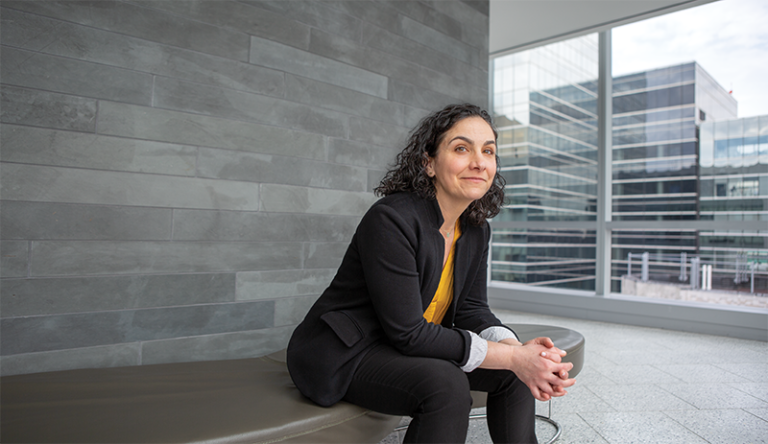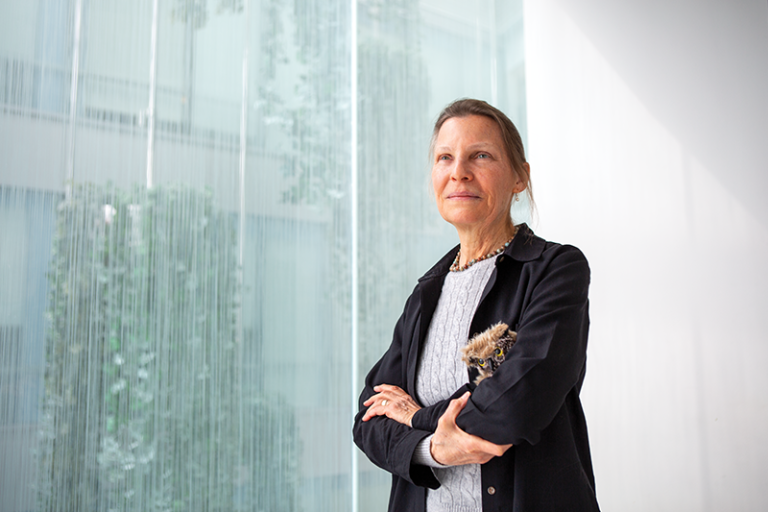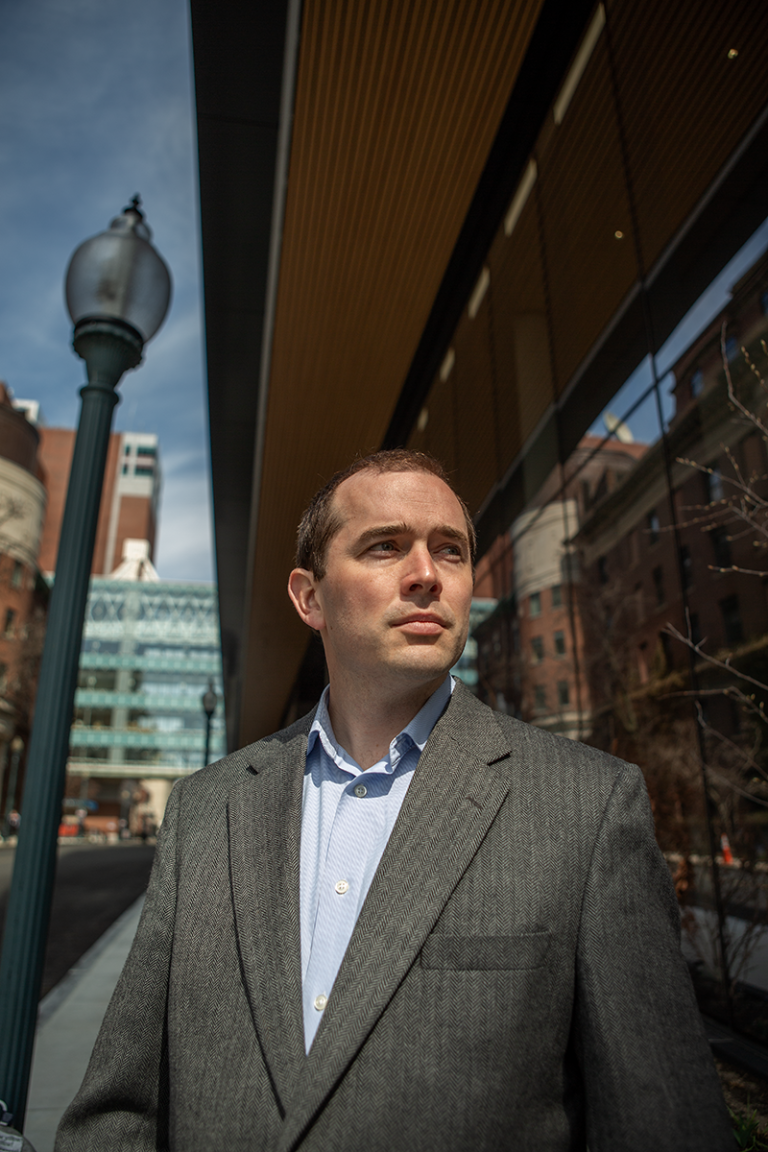Climate Anxiety
The existential threat posed by climate change is deeply troubling to many young people
- 16 minute read
- Feature

Iceberg IX — Greenland 2010
Sebastian Copeland
Photograph
Listen to this story
Elizabeth Pinsky used to think of climate change as less a near-term threat than one whose effects loomed in the distant future. Then headlines about a 2018 climate report from the United Nations caught her eye. In the report, scientists claimed that if greenhouse gas emissions continue unabated, rising sea levels caused by warming temperatures would likely inundate some global coastlines and intensify droughts and poverty in other parts of the world by 2040. This was far sooner than previously projected. “I immediately thought of my two young kids,” says Pinsky, MD ’06, a child and adolescent psychiatrist at Massachusetts General Hospital. “I wondered what the world would look like to them. I started realizing these changes might affect their lives profoundly — and that would likely affect mine as well.”
A global survey published in Lancet Planetary Health in 2021 reported that among an international cohort of more than 10,000 people between the ages of 16 and 25, 60 percent described themselves as very worried about the climate and nearly half said the anxiety affects their daily functioning. Since young people expect to live longer with climate-related crises than their parents will, “they feel grief in the face of what they’re losing,” Pinsky says.

As she feared, damage that threatens the planet’s future — and the anxiety that this threat can engender — is affecting the lives of young people. And it has changed her life: Pinsky now works at the forefront of mental health efforts to help young people manage the emotional burdens of climate change.
Anticipated peril
Compared to threats to our physical health from climate change — heat-related injuries, for instance, or the spread of tropical diseases — its mental health consequences are less researched. But emerging studies reveal a mounting toll, especially among young people. Young survivors of weather-related disasters report high rates of PTSD, depression, sleep deficits, and learning issues. Nearly three quarters of the child and adolescent population in Pakistan experienced learning difficulties after widespread floods devastated the country in 2010.
Young people also suffer emotionally from climate change’s anticipated effects. The twenty-year-old Swedish activist Greta Thunberg, who chastised world leaders for inaction on carbon emissions during a speech at the United Nations in 2019, struggled for years with depression over climate change as young child. For many young people, worry over threats of future climate change results in panic attacks, insomnia, obsessive thinking, and other symptoms. And those feelings are often amplified by a pervasive sense that older people aren’t doing enough to fix the climate problem. “There’s a feeling of intergenerational injustice,” says Lise Van Susteren, a general and forensic psychiatrist based in Washington, DC, who specializes in the mental health effects of climate change. “Many young people feel invalidated, betrayed, and abandoned.”
Managing these issues poses hard challenges. Research on effective interventions is virtually nonexistent, and parents and other people who want to help have little to go on. Professional organizations are only now beginning to provide needed resources. The Climate Psychiatry Alliance, whose members span academia and community care, has a searchable directory of “climate aware” mental health professionals on its website. These sorts of licensed therapists are described by the psychiatry alliance as “professionals who recognize that the climate threat is both a global threat to all life on Earth, and a deeply personal threat to the mental and physical well-being … of each individual, family, and community on the planet.” Another professional group, the Climate Psychology Alliance, provides a similar directory and lists support programs and resources for young people, parents, and teachers.
Social rewards are really powerful in the climate change battle, especially for young people.
Pinsky emphasizes that any attempt to help young people navigate climate-related emotions must start by acknowledging the validity of their fears. News reports and researchers often refer to these feelings collectively as climate anxiety, or eco-anxiety, but Pinsky admits to having misgivings about the terms.
“Many people interpret anxiety as a pathological response that needs to be treated and solved,” she says. “But it’s also a constructive emotion that gives us time to react in the face of danger. And anxiety in the face of climate change is a healthy response to a real threat.”
Some people manage their climate-triggered emotions without spiraling into distress. But others become progressively hyperaroused and panicky, Pinsky says, or else fall into a sort of emotional paralysis. These reactions can be especially debilitating for people who already struggle with underlying mental health disorders. Moreover, anxieties over climate change can interlace with broader feelings of instability over the pace of technological and cultural change, argues Ann-Christine Duhaime, the Nicholas T. Zervas Distinguished Professor of Neurosurgery at HMS, an associate director of the Mass General Center for Environment and Health, a pediatric neurosurgeon at Mass General, and author of Minding the Climate, recently published by Harvard University Press, which explores connections between environmental crises and neuroscience. “Technology is accelerating faster than culture can keep up, and humans in general are unmoored and struggling to adapt,” she says. “For some people, climate change is psychologically the last straw. You realize you can no longer count on the stability of your planet, your atmosphere — your very world.”
Ways of coping
Counselors who work in this area travel in relatively uncharted territory, especially when it comes to managing anticipatory anxiety over future climate effects. Van Susteren describes that anxiety as a type of pre-traumatic stress disorder, with few existing precedents in the United States apart from fears of nuclear annihilation and the decades-ago experience of living through classroom drills on how to survive an atom bomb attack. Talk therapy for anxiety typically aims to help people identify and replace irrational thoughts, called cognitive distortions, with alternative thinking that isn’t so stressful. But since climate anxiety is based on rational fears, this particular approach risks alienating anyone who might feel their worries are being dismissed.
“You don’t want to give the impression that the client’s anxiety is exaggerated, or rooted in some experience from childhood,” says Andrew Bryant, a clinical social worker with a private practice in Seattle, Washington. “Otherwise, clients will think ‘this person doesn’t get me’ or ‘he’s in denial.’ They will leave and not come back.”
Bryant began specializing in climate anxiety in 2016, after nearby forest fires left much of Washington State blanketed in heavy smoke. Warming temperatures are fueling larger, more destructive fires in the Pacific Northwest, and, for Bryant, their effects on air quality were a wake-up call “that climate change was something that my clients and I are living with right now.” Younger people were increasingly arriving at Bryant’s office frightened, depressed, and confused about how to manage climate-triggered emotions. Some were even wondering if they should bring children into such a world.
Bryant says his first step during counseling is simply to have people identify and express their feelings about these issues. “We’re not saying that anxiety is good or bad,” he says. “We just want to bring those feelings out into the open. It’s more about validating that climate concerns are reasonable given what we’re reading in the news every day.”

Emerging evidence suggests that young people do best by cultivating a sense of agency and hope despite their climate concerns. The aim during therapy is for them “to engage with the world in a way that feels more meaningful and in alignment with who they are,” Bryant says. But getting to that point involves talking through feelings like despair, grief, or rage first. Without doing that, he says, many people get stuck in maladaptive coping strategies that can lead to burnout, frustration, or hopelessness. Bryant describes jumping into an urgent, problem-focused coping strategy as “going into action mode so you don’t have to feel any grief.”
Problem-focused coping has a societal benefit in that it leads to “pro-environmental behavior,” meaning that young people who engage in it typically spend a lot of time learning about climate change and focusing on what they can do personally to help solve the problem. But climate change is far beyond any one person’s control, and problem-focused coping can leave people frustrated by the limits of their own capacity and make them unable to rid themselves of resulting worry and negative emotions, according to Maria Ojala, an associate professor in psychology at Örebro University in Sweden.
Ojala studies how younger people think, feel, and communicate about global environmental problems and is an author of a 2019 paper in Environment and Behavior on coping strategies young people are using to deal with their climate change concerns. In it, she and her colleagues describe emotion-focused coping, whereby young people ignore or deny climate change as a means of avoiding feeling anxious about it. In an email, Ojala notes that people who gravitate toward emotional distancing typically come from families that communicate about social problems in “pessimistic doom-and-gloom ways.” But since one type of emotion-focused coping involves de-emphasizing the climate threat, she says, it also precludes actions young people might take against it, and therefore has no environmental upside.
Ojala and other experts favor a third coping strategy that balances negative feelings about climate change with faith in the power of social forces working to overcome it. Called meaning-focused coping, this approach takes strength from individual actions and climate beliefs, while “trusting that other societal actors are also doing their part,” Ojala says in her paper. And since meaning-focused coping allows negative and positive climate emotions to coexist, young people who adopt it have an easier time maintaining hope for the future.
Pinsky would agree. The overall goal, she says, is for young people to achieve more resilience in the face of climate change, so they can function in spite of their environmental concerns. When people find meaning in what they do, she says, they have a greater sense of their own agency and self-efficacy. “You’re more empowered to take action, and that can be a powerful way to deal with strong negative emotions,” Pinsky says.
But Duhaime cautions that anyone taking action against climate change should know they shouldn’t expect a quick payback. The brain’s reward system, which forms a core of human decision-making, evolved over eons of history to strengthen neural associations between actions and outcomes that promote short-term survival. And that system, she says, responds to the immediate consequences of what we do. One problem with climate change, Duhaime says, is that because it’s so vast and complex, people can’t assume that any single act will lead to a discernible effect on its trajectory. So, in place of near-term climate improvements, Duhaime says young people may benefit from seeking the rewards that come from being part of a group or a movement working to advance an agenda that furthers actions that protect the planet’s climate. “Social rewards are really powerful in the climate change battle, especially for young people,” Duhaime says. Recognizing the mismatch between how the brain processes reward and the novel challenges of the climate crisis may help people persist when it feels frustrating and ineffective compared to causes with more immediately visible effects. Even if you don’t see climate improvements or policy changes right away, she says, “that won’t diminish the importance of engaging in these efforts.”
Strength from unity
That theme resonates with Julia Malits, a fifth-year MD candidate at HMS and a graduate of the Harvard T.H. Chan School of Public Health. Malits says that like many of her peers, she grew up with a certain amount of climate anxiety, which she attributes to being overwhelmed by the scale of the problem and the immense effort required to address it. But Malits adds that she wasn’t overly burdened by her emotions. “I’m an optimist by nature and feel that society does have the capacity to make needed changes,” she says. “And what also helps me avoid climate anxiety on a daily basis is the community that I’ve been lucky enough to connect with here at Harvard. It helps to surround yourself with people who are similarly worried about these issues and are also engaging with you on solutions, in whatever capacity is meaningful to you.”
Malits says her interest in the health effects of climate change blossomed during conversations with professors and other HMS students. She became a student ambassador with the Harvard Chan Center for Climate, Health, and Global Environment (C-CHANGE), which has a mission to deliver solutions-based research that shapes climate actions — especially those that improve health for vulnerable populations.

In January, following a presentation delivered by Gaurab Basu, an HMS instructor and primary care physician with Cambridge Health Alliance, and jointly developed by Malits, Madeline Kline, a student in the Harvard/MIT MD-PhD program, and HMS students in an environment and medicine interest group, the HMS Educational Policy and Curriculum Committee voted to officially incorporate climate change and health into the MD curriculum as a priority societal theme. The curricular change builds on the pioneering work of students, faculty, and alumni, such as Eric Chivian, MD ’68, who founded and directed the HMS-based center that is now C-CHANGE, and Aaron Bernstein, an HMS assistant professor of pediatrics at Boston Children’s Hospital and former interim director of C-CHANGE.
Thanks to their efforts, climate themes will now be integrated into existing courses across all four years of the MD program and cover topics such as how climate change affects human health, how health care systems contribute to the problem, and how physicians can help in the move toward solutions.
“Climate anxiety is an important catalyst for the work I do,” Malits says. “I think you need avenues to channel it and talk about it with loved ones and peers, and have communities through which you can process those feelings and come up with remedies.” Collaborative activism dampens the anxiety, Malits says, and gives young people a sense of renewed hope for the future. “That’s why it’s important to roll up your sleeves and think about how you’d like to tackle the problem,” she says.
But Malits says she worries most about how climate change is affecting marginalized communities, singling out those who live in urban heat islands, where inadequate green space intensifies extreme heat. While it’s true that extreme weather events are occurring with mounting frequency in wealthier nations, many countries in the developing world continue to bear the brunt of the climate problem.
The problem at our doorstep
Indeed, the countries suffering most from climate change now are also the least able to respond to its psychological effects. In Somalia — which is one of the poorest countries in sub-Saharan Africa — climate change is fueling the worst drought in decades and putting 8 million people, nearly half the population, at risk for famine. Catastrophic floods linked to climate change in Pakistan recently affected more than 33 million people living in the area. In addition, according to 2019 data from the World Bank, nearly 30 percent of Honduras’s population works for the agricultural sector, where rising temperatures and drought are contributing to a mass exodus, as documented that year by PBS NewsHour.
Researchers are finding that young people with the most extreme fears over climate change live predominantly in the developing world. The Philippines and India, for instance, are near the top of a list of recently surveyed countries where young people report climate-driven feelings that “humanity is doomed” and “the future is frightening.”
Mental health systems in the developing world need more resources to deal with this growing crisis, cautions Caleb Dresser, an emergency medicine physician at Beth Israel Deaconess Medical Center and a fellow at Harvard Chan School’s C-CHANGE. Disasters linked with climate change can create huge mental health needs, Dresser says, “and while many good programs and organizations step in to help, the need for services easily outpaces resources both during and after the disaster occurs.” Nearly a year after Hurricane Andrew struck South Florida in 1992, 18 percent of children living in the area were still struggling with PTSD-like symptoms, and nearly 30 percent of those who lived through Hurricane Katrina in 2005 wound up with complicated grief, in which strong feelings of loss linger for a long time.
Dresser leads research focused on the health implications of climate change, especially in terms of its effects on emergency care and operations during extreme weather events. In 2017, he cared for people who had left Puerto Rico for Boston after Hurricane Maria decimated the island. Many were suffering emotional trauma as a result of both the storm and having been uprooted from their communities.
“We know from other displacement events in history that seeking life in a new location is extraordinarily stressful and comes with long-term risks of anxiety and depression related to a loss of place and a change in one’s sense of self,” Dresser says.
Emergency responders need to be ready for the forced migration of people affected by climate change, Dresser says, adding that many could benefit from access to care for mental health problems.
Even when people are not uprooted by disaster, a variety of climate-related mechanisms can affect their mental health or the safety of their mental health treatment. High heat and humidity worsen irritability and cognition, he points out, and they can also exacerbate side effects from some common psychiatric medications. Levels of lithium — a mood stabilizer used for treating bipolar disorder and major depression — can rise to potentially toxic concentrations in a person who is perspiring heavily; they can become dehydrated and may develop impaired kidney funtion, potentially causing tremor, slurred speech, confusion and other dangerous effects. In addition, serotonin-reuptake inhibitors, tricyclic antidepressants, and benzodiazepines may affect the body’s physiological response to heat with varied effects on blood pressure, sweating, and cognition. Patients with chronic mental health issues are at increased risk during hot weather and more likely to need emergency care. In extreme cases, heatstroke can occur, with potentially fatal results.
Pinsky points out that even as the effects of climate change on pediatric mental health are increasingly recognized, research in the field is in its early stages. She was an author on a 2022 Academic Psychiatry paper investigating the perspectives of more than a dozen scientists who work in this area. They identified several pending needs, including additional interventions to support and foster the resilience of young people experiencing climate anxiety, more funding, and the removal of logistical barriers that block access to care for affected individuals. Resistance from colleagues in the field was also raised as an issue. Pinsky and others stress that efforts aimed at responding to the mental health challenges of climate change must engage with broader work aimed at removing the root cause of the problem: our reliance on fossil fuels.
Pinsky now works with several organizations to raise awareness of climate change, including the Mass General Center for the Environment and Health and the new Youth Working Group of the Climate Psychiatry Alliance, which had its launch meeting in April 2023. And like others on the front lines of the climate change battle, she has her hands full as the pace of warming only accelerates.
According to the latest report from the United Nations Intergovernmental Panel on Climate Change, released on March 20, it is likely that without swift action, the world will exceed a global average temperature increase of 2.7 degrees Fahrenheit above preindustrial levels by 2030. Beyond that threshold, the panel warned, heat waves, crop failures, the spread of infectious diseases, floods, and species extinctions could outstrip humanity’s capacity to adapt. Warming will cease only if humans stop adding heat-trapping gases to the atmosphere.
“I believe the fundamental and best treatment for youth climate distress is a rapid and just transition from fossil fuels,” Pinsky says. “I genuinely consider all that work to be in the area of mitigating climate anxiety.”
Charles Schmidt is a writer based in Maine.
Images: Sebastian Copeland (top); John Soares (Pinsky, Duhaime, Dresser)